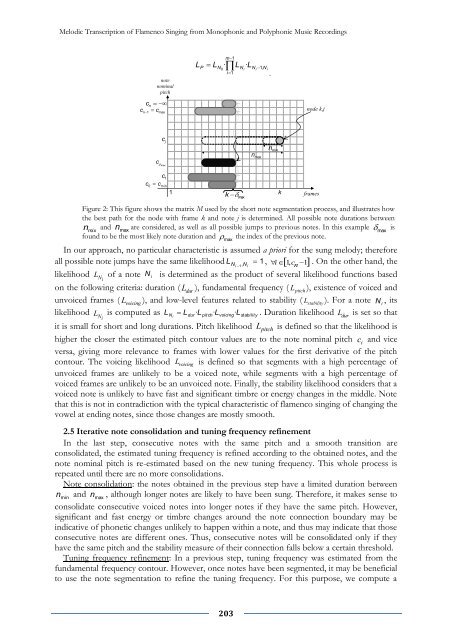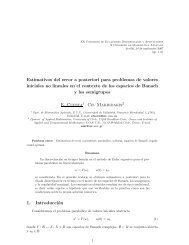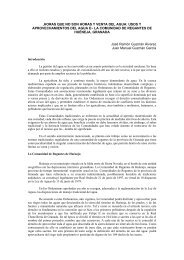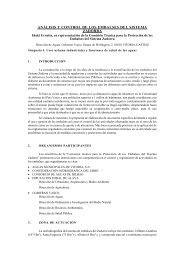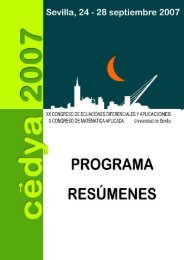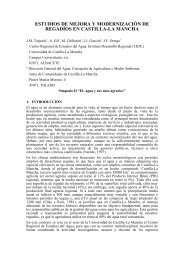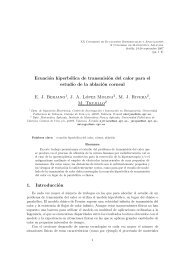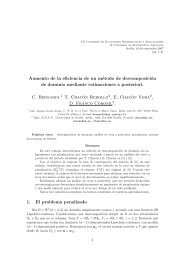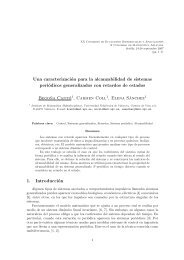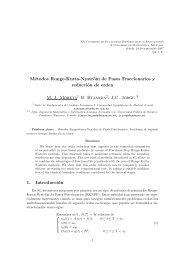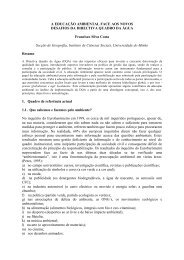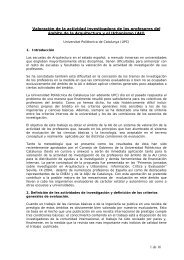LIBRO DE ACTAS (pdf) - Universidad de Sevilla
LIBRO DE ACTAS (pdf) - Universidad de Sevilla
LIBRO DE ACTAS (pdf) - Universidad de Sevilla
You also want an ePaper? Increase the reach of your titles
YUMPU automatically turns print PDFs into web optimized ePapers that Google loves.
Melodic Transcription of Flamenco Singing from Monophonic and Polyphonic Music Recordings<br />
note<br />
nominal<br />
pitch<br />
c <br />
c c<br />
n<br />
n1<br />
max <br />
c j<br />
c max<br />
c 1<br />
c0 cmin<br />
1<br />
m1<br />
L L · L<br />
· L<br />
P N0 Ni Ni 1,<br />
Ni<br />
i 1<br />
k max<br />
203<br />
n max<br />
.<br />
n min<br />
k<br />
no<strong>de</strong> k,j<br />
Figure 2: This figure shows the matrix M used by the short note segmentation process, and illustrates how<br />
the best path for the no<strong>de</strong> with frame k and note j is <strong>de</strong>termined. All possible note durations between<br />
n and n mix max are consi<strong>de</strong>red, as well as all possible jumps to previous notes. In this example is max<br />
found to be the most likely note duration and the in<strong>de</strong>x of the previous note.<br />
max<br />
In our approach, no particular characteristic is assumed a priori for the sung melody; therefore<br />
all possible note jumps have the same likelihood LN 1<br />
i 1, N , i1, c 1<br />
i<br />
n . On the other hand, the<br />
likelihood L N of a note N i is <strong>de</strong>termined as the product of several likelihood functions based<br />
i<br />
on the following criteria: duration ( L dur ), fundamental frequency ( L pitch),<br />
existence of voiced and<br />
unvoiced frames ( L voicing ), and low-level features related to stability ( L stability ). For a note N , its i<br />
likelihood L is computed as L · · ·<br />
N<br />
N L<br />
i dur L pitch Lvoicing Lstability<br />
. Duration likelihood L<br />
i<br />
dur is set so that<br />
it is small for short and long durations. Pitch likelihood L pitch is <strong>de</strong>fined so that the likelihood is<br />
higher the closer the estimated pitch contour values are to the note nominal pitch c i and vice<br />
versa, giving more relevance to frames with lower values for the first <strong>de</strong>rivative of the pitch<br />
contour. The voicing likelihood L voicing is <strong>de</strong>fined so that segments with a high percentage of<br />
unvoiced frames are unlikely to be a voiced note, while segments with a high percentage of<br />
voiced frames are unlikely to be an unvoiced note. Finally, the stability likelihood consi<strong>de</strong>rs that a<br />
voiced note is unlikely to have fast and significant timbre or energy changes in the middle. Note<br />
that this is not in contradiction with the typical characteristic of flamenco singing of changing the<br />
vowel at ending notes, since those changes are mostly smooth.<br />
2.5 Iterative note consolidation and tuning frequency refinement<br />
In the last step, consecutive notes with the same pitch and a smooth transition are<br />
consolidated, the estimated tuning frequency is refined according to the obtained notes, and the<br />
note nominal pitch is re-estimated based on the new tuning frequency. This whole process is<br />
repeated until there are no more consolidations.<br />
Note consolidation: the notes obtained in the previous step have a limited duration between<br />
n min and n max , although longer notes are likely to have been sung. Therefore, it makes sense to<br />
consolidate consecutive voiced notes into longer notes if they have the same pitch. However,<br />
significant and fast energy or timbre changes around the note connection boundary may be<br />
indicative of phonetic changes unlikely to happen within a note, and thus may indicate that those<br />
consecutive notes are different ones. Thus, consecutive notes will be consolidated only if they<br />
have the same pitch and the stability measure of their connection falls below a certain threshold.<br />
Tuning frequency refinement: In a previous step, tuning frequency was estimated from the<br />
fundamental frequency contour. However, once notes have been segmented, it may be beneficial<br />
to use the note segmentation to refine the tuning frequency. For this purpose, we compute a<br />
frames


